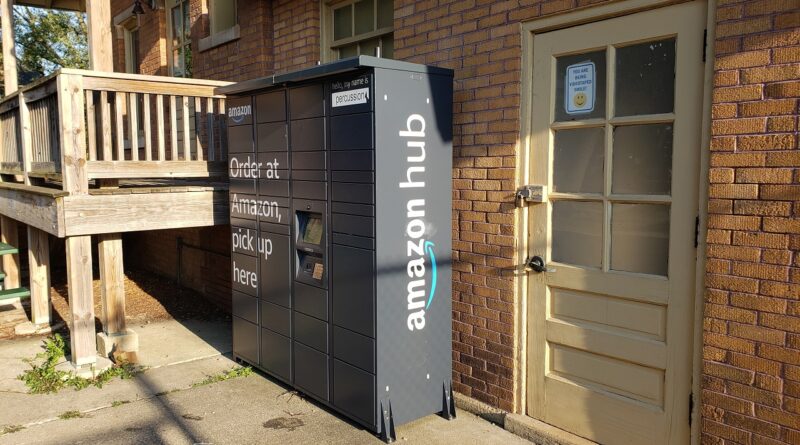A Bad Week for Chicago’s Public Parks
Podcast: Play in new window | Download (Duration: 2:02:45 — 58.5MB)
Subscribe: Apple Podcasts | Spotify | Android | iHeartRadio | Podchaser | Email | TuneIn | RSS | More
(August 22, 2021) Ever see the film 2001: A Space Odyssey? Remember the mysterious huge black monoliths? They recently began appearing in Chicago. Well, these are a little different. First, they bear the name “Amazon.” Second, we all know their purpose. To sell stuff. More accurately, to deliver stuff for Amazon. Some live on business properties. But some appeared in Chicago’s parks. That was part of a bad week for those parks. The public learned about it in an article in Chicago Block Club. Reporter Mina Bloom wrote about Brands Park in the 33rd Ward.
The retail giant on Thursday installed a large Amazon delivery locker atop a sidewalk running through the park, partially blocking the path and drawing immediate scorn and bewilderment from park users and the local alderwoman.
In Facebook comments, locals said the new Amazon “hub” is not only unsightly, but is also a glaringly obvious safety concern because it prevents people with strollers and people in wheelchairs from easily passing through the public park.
Ald. Rosanna Rodriguez was caught off guard by the installation. She says a park supervisor told her it was put there in error. The Chicago Park District corrected that statement. A spokesperson said, “The locker was installed in the correct park.” The story stated that 68 of the lockers were being installed. Subsequently, reports put the number at 102.
Meanwhile, Amazon removed some of the lockers. A petition against the installations was started. At this writing, more than 10,000 people have signed it. That number continues to climb. I contacted Juanita Irizarry, executive director for Friends of the Parks. She, too, found out about the lockers after the fact. Ultimately, though, the question is less about lockers blocking sidewalks than whether they belong in parks at all.
More trouble
Then, just days after that brouhaha, more trouble struck. The Chicago Park District’s deputy inspector general said he was suspended as an attempt to whitewash an investigation into sexual harassment among the district’s lifeguards. A bad week was getting worse.
Irizarry agreed to visit our show this week. As part of their mission, she says Friends of the Parks sometimes must help to exert public pressure on the Park District. In essence, FOTP serves as a watchdog, even though the Park District has its own watchdogs. Some of whom have been suspended. And both issues reveal a disturbing lack of transparency from that department. We will discuss that today.
We will also talk about Friday’s Supreme Court decision. The high court refused to block construction of the Barack Obama presidential center in Jackson Park. Some people view that as good news. Others do not. Meanwhile, there’s still trouble on Chicago’s southeast side. The Army Corps of Engineers still wants to expand a toxic sludge facility. FOTP and others say it should be turned into park land.
Who says keeping track of our parks is easy? Juanita Irizarry joins us today to talk about a bad week for the parks but how it can get better.
Learning to love tropical plants
Marianne Willburn wants you to grow tropical plants successfully. However, she says it’s okay to kill them, too. That’s not as contradictory as it might seem. To understand her philosophy, you should pick up her new book, Tropical Plants and How to Love Them.
If her name sounds familiar, it’s because she stopped by the show earlier this year. She and Susan Harris talked about their work on the Garden Rant website. I promised her that we would invite her back to talk about her new book, just published this year. Today, I’m happy to honor my promise. BTW, you can also find her at her own website, Small Town Gardener.
If you know nothing about tropical plants, you will love this book. If you know plenty about tropicals, I suspect you will still love the book. In the latter case, it’s because Willburn shows you how to get creative with them. She divides the book (and the plants) into…uh…very personal categories.
- The Summer Romance
- The Long-Term Commitment
- The Best Friend
- The High-Maintenance Partner
- Friends with Benefits

See? You’re interested already! That said, the only sex in this book is about propagation. However, you might swoon from the gorgeous plants on display. They range from the truly exotic (Brugmansia and Xanthosoma) to the almost common (Caladium and Dracaena). Willburn even temps you with ways to add tropicals to your meals. But be careful out there, folks. Know what you are doing before you feed an unknown genus to your family.
Why tropicals?
Willburn says they have the potential to
- Give you star power during the hot, often humid days of summer and early autumn.
- Accentuate water features or accentuate wetter areas in the garden.
- Add an unusual element to traditional plantings
- Create a themed tropical garden.
- Create a sense of enclosure and privacy on decks and patios.
- Thrill you taste buds with fresh, unusual flavors.
- Create a lush indoor garden.
- Allow you to experiment with exotic plants that, by virtue of their hardiness, won’t become an invasive threat in your garden.
Amen. Let’s talk tropicals.


